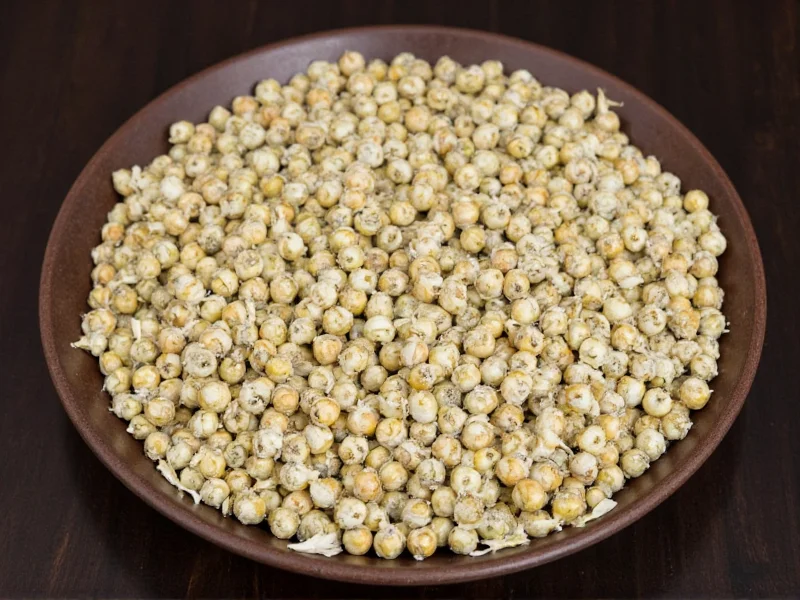Unlike their more common black counterparts, white peppercorns undergo a unique fermentation process that significantly alters their chemical composition and sensory profile. When ripe red peppercorns are soaked in water for 7-10 days, enzymatic activity breaks down the outer pericarp, which is then mechanically removed to reveal the pale seed inside. This transformation reduces the piperine content by approximately 20% while increasing certain volatile compounds responsible for white pepper's distinctive musty, earthy undertones.
The Science Behind White Peppercorn Production
The traditional wet processing method creates notable biochemical differences compared to black pepper's sun-drying technique. During the soaking phase, natural enzymes convert certain pungent compounds into less volatile forms, resulting in a delayed heat sensation that builds gradually rather than delivering an immediate sharp punch. Food scientists have identified over 40 distinct aroma compounds in white pepper, with 3-carene and pinene contributing significantly to its characteristic pine-like notes.
| Characteristic | White Peppercorn | Black Peppercorn |
|---|---|---|
| Processing Method | Soaked & outer layer removed | Sun-dried with outer layer intact |
| Harvest Time | Fully ripe (red stage) | Underripe (green stage) |
| Heat Level (Scoville) | 10,000-12,000 | 12,000-15,000 |
| Primary Flavor Notes | Earthy, musty, sharp heat | Floral, citrus, complex heat |
| Best Culinary Applications | Light sauces, mashed potatoes, Chinese cuisine | General seasoning, dark sauces, meat rubs |
Culinary Applications and Flavor Pairing
Chefs worldwide leverage white peppercorn's unique properties in specific applications where visual presentation matters. In French cuisine, it's essential for classic béchamel and velouté sauces where black specks would compromise the elegant appearance. Chinese cooking traditions utilize white pepper in wonton fillings and hot and sour soup for its penetrating heat that withstands prolonged cooking. The spice's lower volatility makes it particularly effective in liquid-based preparations, as its flavor compounds remain stable during extended simmering.
When considering white peppercorn substitution in recipes, understand that direct 1:1 replacement often fails to deliver equivalent results. For dishes requiring white pepper's visual neutrality, consider using freshly ground black pepper through a fine mesh sieve to remove visible particles. Alternatively, pink peppercorns offer visual similarity but with markedly different flavor chemistry. The most accurate substitute combines 75% black pepper with 25% cayenne for heat adjustment and a pinch of ground ginger to approximate white pepper's earthy notes.
Storage and Quality Assessment
Proper storage significantly impacts white peppercorn's shelf life and flavor retention. Exposure to light accelerates the degradation of key aroma compounds, particularly the monoterpene hydrocarbons responsible for its characteristic pine notes. Store in an airtight container away from heat sources, where they'll maintain optimal flavor for 18-24 months compared to black pepper's 24-36 month viability. High-quality white peppercorns should exhibit uniform pale beige coloration without dark spots, which indicate incomplete removal of the outer pericarp or moisture damage.
When evaluating white peppercorn quality, professional chefs perform a simple solubility test: place a few berries in warm water for 5 minutes. Premium quality peppercorns will release a clear, pale yellow infusion, while lower grades often produce cloudy or brownish liquid indicating improper processing or contamination. The most prized varieties originate from Vietnam's Phu Quoc island and China's Hainan province, where specific terroir conditions create peppercorns with higher concentrations of the sesquiterpene compounds that contribute to their distinctive aroma profile.
Common Misconceptions Addressed
Many home cooks mistakenly believe white pepper is milder than black pepper, when in reality its heat manifests differently due to altered piperine distribution. Scientific analysis shows white pepper contains comparable capsaicinoid levels but delivers heat more gradually because the removal of the outer layer changes how piperine interacts with taste receptors. Another prevalent myth suggests white pepper is simply bleached black pepper - a practice that was occasionally used historically but is now virtually nonexistent in quality products due to strict international food safety regulations.
Frequently Asked Questions
What's the primary difference between white and black peppercorn?
White peppercorns come from fully ripe berries with the outer fruit layer removed through soaking and fermentation, resulting in a cleaner, sharper heat profile. Black peppercorns are made from underripe berries sun-dried with their outer layer intact, creating more complex floral and citrus notes alongside their heat.
Can I substitute black pepper for white pepper in recipes?
Direct substitution often fails because of flavor and visual differences. For appearance-sensitive dishes, strain black pepper through fine mesh. For flavor matching, use 75% black pepper plus 25% cayenne and a pinch of ginger. In creamy sauces, the visual difference matters more than flavor profile.
Why does white pepper sometimes have a musty flavor?
This characteristic earthiness comes from the fermentation process during production. Properly processed white pepper should have clean, sharp heat with subtle pine notes. Musty or moldy flavors indicate improper drying or storage conditions after processing.
Which cuisines use white peppercorn most prominently?
Chinese cuisine features white pepper in wonton fillings and hot and sour soup. French cooking uses it in béchamel and velouté sauces. Scandinavian dishes incorporate it in potato salads and fish preparations. These traditions developed partly for visual presentation in light-colored dishes.











 浙公网安备
33010002000092号
浙公网安备
33010002000092号 浙B2-20120091-4
浙B2-20120091-4